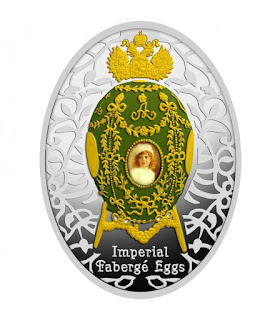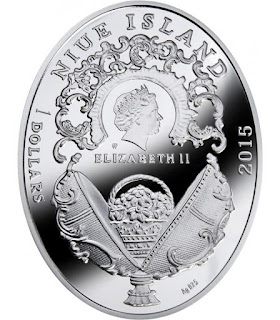Niue 1 Dollar Silver Coin 2015 Alexander Palace Egg - Imperial Faberge Eggs
Series: Imperial Fabergé Eggs
Reverse: In the foreground you will see an image of the beautiful Imperial Egg with 24-carat gold plated elements. There are finely engraved ornaments in the background of the coin. The Egg offsets itself from the background, due to the applied gold. In the middle of the egg you will find an replica of the original egg. (Portrait of the Successor to the throne Tsarevich Alexei Nikolaevich Romanov of Russia (1904-1918), (circa 1907). The Tsarevich Alexei Nicolaevich Romanov, youngest child and only son of Tsar Nicholas II and Empress Alexandra.)
The Alexander Palace (Russian: Александровский дворец) is a former imperial residence at Tsarskoye Selo, on a plateau around 30 minutes by train from St Petersburg. It is known as the favourite residence of the last Russian Emperor, Nicholas II, and his family and their initial place of imprisonment after the revolution that overthrew the Romanov dynasty in early 1917. The Alexander Palace is situated in the Alexander Park, not far from the larger Catherine Palace. Today it is undergoing renovation as a museum housing relics of the former imperial dynasty.
Country: Niue Island.
Year of Issue: 2015.
Metal: Silver.
Silver Fineness: Ag 925/1000.
Content: 0.54 Troy OZ.
Denomination: 1 NZD - legal tender in New Zealand.
Weight: 16.81 g.
Diameter: Ellipse 39 x 29.20 mm.
Quality: Proof.
Mintage: 9,000.
Exterior Decoration: Zircons and Elements in Polished Finish.
Producer: Mint of Poland (Mennica Polska).
Series: Imperial Fabergé Eggs
Alexander Palace Egg - Imperial Faberge Eggs
The Alexander Palace Egg is a jewelled Easter egg made under the supervision of the Russian jeweler Peter Carl Fabergé in 1908, for the then Tsar of Russia, Nicholas II. Nicholas presented it as an Easter gift to his wife, Alexandra Fyodorovna. It is held in the Kremlin Armoury Museum in Moscow.
Design
The Alexander Palace Egg is made of Siberian nephrite, diamonds, gold, rubies and miniature watercolor paintings on ivory. The outside of the egg contains five miniature watercolor portraits of the children of Nicholas II and Empress Alexandra: Olga, Tatiana, Maria, and Anastasia and the Tsarevitch Alexei. Above each portrait is a diamond monogrammed initial of each child's first name. On the reverse of each portrait, visible only from the inside of the egg, is the date of birth of each child, including Olga- November 3, 1895, Tatiana- May 29, 1897, Maria- June 14, 1899, Anastasia- June 5, 1901, Alexei- July 30, 1904. The remainder of the egg's surface is divided by five vertical lines, studded with diamonds and connected with one another by gold garlands inlaid with rose and ruby flowers. The dividing line between the upper and lower sections of the egg also have golden leaves, rubies and diamonds, together with two triangular diamonds with Alexandra's initials, AF.
Surprise
The surprise is a detailed replica of the Alexander Palace, the Russian Imperial family's favorite residence in Tsarskoye Selo. The tiny replica also details the adjoining gardens of the palace. The miniature is made of tinted gold and enamel. The windows are made of rock crystal, the roof of enameled light green. The palace replica is placed on a gold table with five narrow high legs and can be removed from the egg. The base of the replica has an engraved inscription that reads, "The Palace at Tsarkoye Selo."
History
The Alexander Palace Egg was commissioned by Nicholas II in 1908 and presented to Alexandra. It was purchased for 12,300 rubles. From 1913 until 1916 it remained at the Alexander Palace in Alexandra Fedorovna’s Mauve Sitting Room 1913-1916. In 1917 it was confiscated by Kerensky's army during the Russian Revolution, along with many other Imperial treasures. It was transported from the Anichkov Palace to the Kremlin Armoury, where it remained. The Alexander Palace Egg is one of ten Faberge Eggs in the collection at the Kremlin Armoury, Moscow. Others include: Memory of Azov Egg (1881), Bouquet of Lilies Clock egg (1899), Trans-Siberian Railway egg (1900), Clover Leaf egg (1902), Moscow Kremlin egg (1906), Standart egg (1909), Alexander III Equestrian egg (1910), Romanov Tercentenary egg (1913), Steel Military egg (1916).
The stand is a modern reinterpretation, made in 1989 by the Moscow Experimental Jewellery Factory at the suggestion of Fabergé scholar Dr. Valentin Skurlov.

